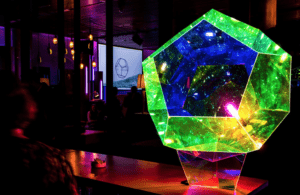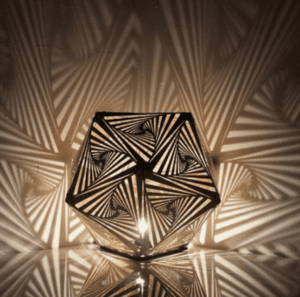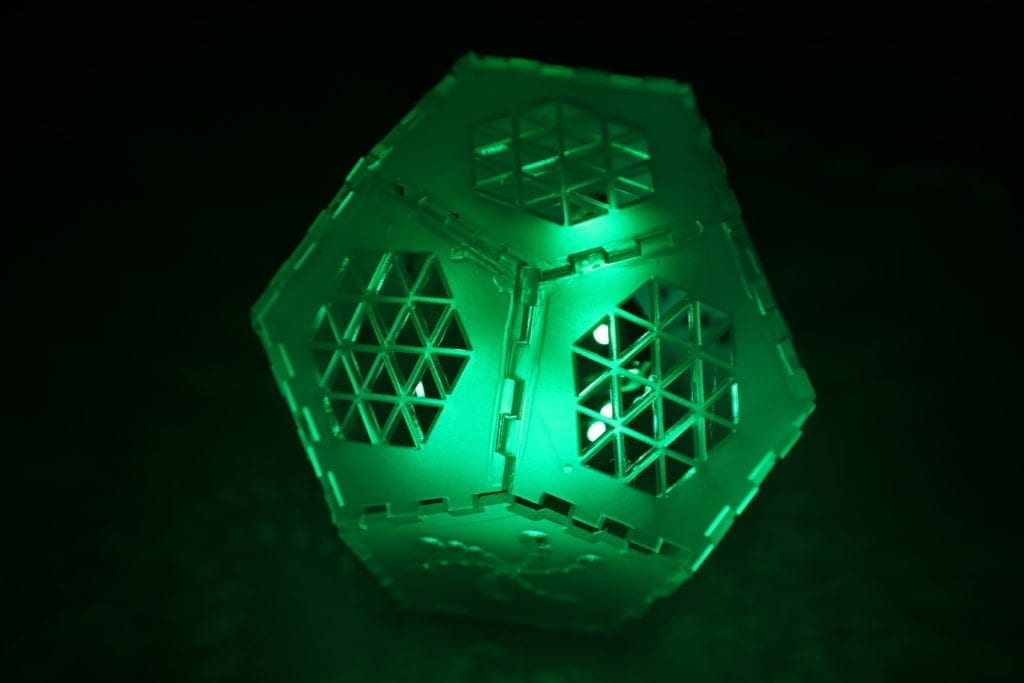Title: Lamp Dodecahedron
Project Description:
For the midterm project, I was inspired by Vincent Buret and his work Mirobolante Light Sculpture. I was especially interested in the shape -dodecahedron and how it is an excellent structure to display light interaction. After doing more research related to this shape, I saw on Pinterest a style of lamp sculptures incorporating light and patterns. Drawing inspirations from these artworks, I decided to create my own dodecahedron lamp using laser cutting and explore further how I can create a project relating this structure to LED light and patterns.
 Mirobolante Light Sculpture
Mirobolante Light Sculpture Pinterest Inspiration
Pinterest Inspiration
Perspective and Context
I was really keen on incorporating shapes on sides of the dodecahedron not only because it creates a beautiful visual effect, but also because it connects with Merleau-Ponty’s view on Space in the book “The World of Perception”. He states that our perceived world is structure by a plurality of overlapping perspectives within which different aspects are somehow seen together. As light shine through the geometric shapes, patterns are created in the space. Depending where the viewer stands, where the light is placed, where the reflective surfaces are, people see different patterns. And there is no absolute right way to enjoy it. Any angle provides an unique viewing experience that when they combine together contribute to the greater perception of space.
Development & Technical Implementation
To get started, I decided to use laser cutting as the fabrication method to create the main structure. I drew twelve pentagons in Illustrator and utilized Joinery to create joint inserts. Here are some photos of the first prototype:
In this case, the prototype did not work out because not all the joints match up exactly. I could not assemble the pieces together. It took more spatial imagination to readjust the illustrator file. I also changed to patterns that create better visual effects. The second attempt is shown here:
I learned that acrylic is quite expensive so when prototyping it is best to go with MDF board. I ended up creating a finished prototype by assembling the pieces and making it into a lamp design. It is connected to a 20v halogen light. The results are as pictured:
While the second prototype works well with a stable, bright light source and I was happy with the result, I wanted to do more with LED lights. However, the problem with LED is that lights do not shine through the wood board. In order to best combine LED lights and the structure, I experimented with some alternative materials – reflective glass and frosted acrylic. I ended up picking frosted acrylic as it best presents the effects I want to achieve.
In the process of prototyping, I also tried several different patterns and finalized two distinct patterns for the top and bottom half of the structure.
In terms of the composition, I tried to maximize the functions of digital LEDs by using both single and mixed colors, and control pixels separately to create a kinetic effect. I worked with the fastLED library and built upon some existing light patterns. Here are the details of the code: https://gist.github.com/ivyshi98/73924a12eb95492240b6a8a09d6df956.
Presentation:
For the presentation, I showcased my MDF lamp first. Even though the light effects are limiting with no change of colors, I still thought this piece creates captivating visuals. And people reacted to it quite well even though it was a simple piece.
Then for the main project, I displayed the frosted acrylic lamp on a MDF board with two sides covered. My intention was for each side to reflect the patterns of the lamp. This is a video of the final result:
Both of my works are self-explanatory. In general, people enjoyed the patterns generated by the interaction of LED lights and the lamp as well as the overall light composition. Some of the feedback and critiques include:
1) Create a generative composition – Instead of considering composition with a duration, I should establish a continuous composition that will let people enjoy the display no matter when they see it. It should not have a clear beginning and end. This is something I can definitely improve by adding additional sequences and program the code so that it randomly selects a sequence. The delay time between will also be tuned so it feels more like a transition rather than a sudden stop.
2) Overall display needs improvement – The main critique is that the lamp itself is beautiful but by putting it on a small, plain DMF board it takes away from the effect. The materials do not match and the base is too small to allow the entirety of the pattern reflection to show. Professor Eric suggested using a white foam board. The overall display is definitely lack of consideration on my part. The overall viewing experience is as important as the main sculpture. Next time I will put more time and efforts into testing different display methods and choose the best one. For this project, I re-ran the project near the corner of a dark room. The effects are improved:
Conclusion:
I learned a lot from the process of making this midterm project. In the development stage, it is important to create prototypes and make improvements each time. Do not expect to get to the final product in one go. In addition, it is a good practice to start the prototype small and inexpensive to not waste time and materials. I made the mistake of using acrylic the first time thinking that it will work. After revising my prototype so many times, I now have a good grasp of laser cutting as a fabrication method.
In terms of presentation, I also learned from the critiques and listed the details in the presentation section. Next time, I will consider making a generative composition as well as carefully designing the overall display. A project can be the most beautiful thing but without providing proper display and best viewing angle(s) to the audience, it is worthless.






